<Back to Index>
- King of Denmark Christian IX, 1818
- King of the Netherlands William III, 1817
- King of Sweden and Norway Oscar II, 1829
PAGE SPONSOR
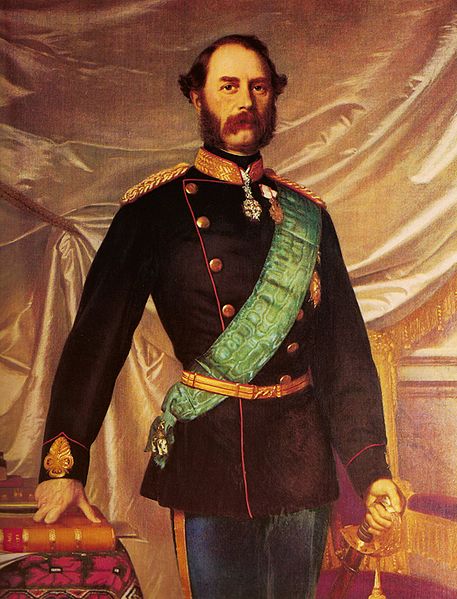
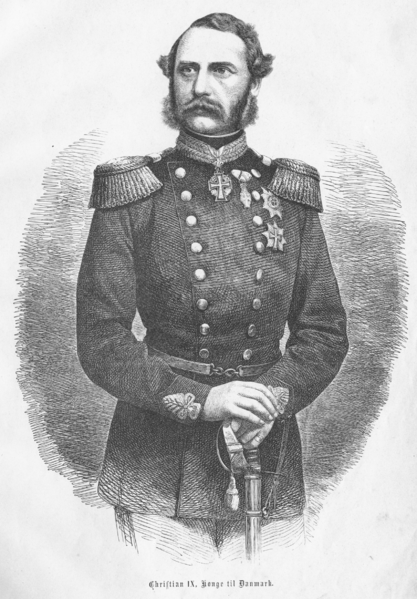
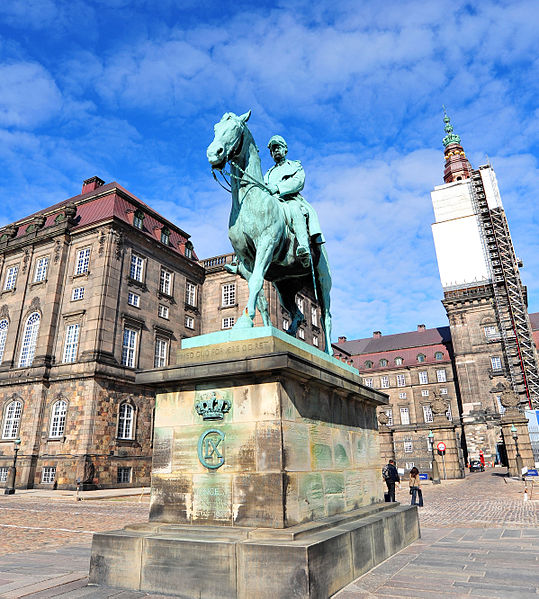
Christian IX (8 April 1818 – 29 January 1906) was King of Denmark from 16 November 1863 to 29 January 1906.
Growing up as a prince of Schleswig - Holstein - Sonderburg - Glücksburg, a junior branch of the House of Oldenburg which had ruled Denmark since 1448, Christian was originally not in the immediate line of succession to the Danish throne. However, in 1852, Christian was chosen as heir to the Danish monarchy in light of the expected extinction of the senior line of the House of Oldenburg. Upon the death of King Frederick VII of Denmark in 1863, Christian acceded to the throne as the first Danish monarch of the House of Glücksburg.
Christian became known as "the father - in - law of Europe", as his six children married into other royal houses. Most recent European monarchs are descended from him, including Queen Elizabeth II of the United Kingdom, King Harald V of Norway and Queen Margrethe II of Denmark. The consorts Prince Philip, Duke of Edinburgh, and Queen Sofía of Spain are also agnatic descendants of Christian IX, as is Constantine II of Greece (the former and last King of the Hellenes).
Christian was born on 8 April 1818 at Gottorp Castle as Prince Christian of Schleswig - Holstein - Sonderburg - Beck, the fourth son of Friedrich Wilhelm, Duke of Schleswig - Holstein - Sonderburg - Beck, and Princess Louise Caroline of Hesse. He was named after Prince Christian of Denmark, the later King Christian VIII, who was also his godfather.
Christian's father was the head of the ducal house of Schleswig - Holstein - Sonderburg - Beck, a junior male branch of the House of Oldenburg. Through his father, Christian was thus a direct male line descendant of King Christian III of Denmark and an (albeit junior) agnatic descendant of Helvig of Schauenburg (countess of Oldenburg), mother of King Christian I of Denmark, who was the "Semi - Salic" heiress of her brother Adolf of Schauenburg, last Schauenburg duke of Schleswig and count of Holstein. As such, Christian was eligible to succeed in the twin duchies of Schleswig - Holstein, but not first in line.
Christian's mother was a daughter of Landgrave Charles of Hesse, a Danish Field Marshal and Royal Governor of the duchies of Scheswig and Holstein, and his wife Princess Louise of Denmark, a daughter of Frederick V of Denmark. Through his mother, Christian was thus a great - grandson of Frederick V, great - great - grandson of George II of Great Britain and a descendant of several other monarchs, but had no direct claim to any European throne.
On 6 June 1825, Duke Friedrich Wilhelm was appointed Duke of Glücksburg by hisbrother - in - law Frederick VI of Denmark, as the elder Glücksburg line had become extinct in 1779. He subsequently changed his title to Duke of Schleswig - Holstein - Sonderburg - Glücksburg and founded the younger Glücksburg line.
From an early age, Christian grew up in Denmark and was educated in the Military Academy of Copenhagen.
As a young man, Christian unsuccessfully sought the hand of his third cousin, Queen Victoria, in marriage. At the Amalienborg Palace in Copenhagen on 26 May 1842, he married his second cousin, Louise of Hesse - Kassel (or Hesse - Cassel), a niece of Christian VIII.
In 1847, with the approval of the great powers of Europe, Christian was chosen by King Christian VIII to be heir presumptive after the extinction of the most senior line to the Danish throne, as the future Frederick VII seemed incapable of fathering children. A justification for this choice was his marriage to Louise of Hesse - Kassel, who - as a great - niece of Christian VII - was a closer heir to the throne than her husband.
Frederick VII's childlessness had presented a thorny dilemma and the question of succession to the Danish throne proved problematic. Denmark's adherence to the Salic Law and a burgeoning nationalism within the German speaking parts of Schleswig - Holstein hindered all hopes of a peaceful solution. Proposed resolutions to keep the two Duchies together and part of Denmark proved unsatisfactory to both Danish and German interests. While Denmark had adopted the Salic Law, this only affected the descendants of Frederick III of Denmark, who was the first hereditary monarch of Denmark (before him, the kingdom was officially elective). Agnatic descent from Frederick III would end with the death of the childless King Frederick VII and his equally childless uncle, Prince Ferdinand. At that point, the law of succession promulgated by Frederick III provided for a Semi - Salic succession. There were, however, several ways to interpret to whom the crown could pass, since the provision was not entirely clear as to whether a claimant to the throne could be the closest female relative or not.
As the nations of Europe looked on, the numerous descendants of Helvig of Schauenburg began to vie for the Danish throne. Frederick VII belonged to the senior branch of Helvig's descendants. In 1863, Frederick, Duke of Schleswig - Holstein - Sonderburg - Augustenburg (1829 – 1880) (the future father - in - law of Kaiser Wilhelm II of Germany), proclaimed himself Frederick VIII of Schleswig - Holstein. Frederick of Augustenburg became the symbol of the nationalist German independence movement in Schleswig - Holstein after his father (in exchange for money) renounced his claims as first - in - line to inherit the twin - duchies of Schleswig and Holstein. Following the London protocol of 8 May 1852, which concluded the First War of Schleswig, and given his father's renunciation, Frederick was deemed ineligible to inherit.
The closest female relatives of Frederick VII were his paternal aunt, Princess Louise Charlotte of Denmark, who had married a scion of the cadet branch of the House of Hesse, and her daughters. However, they were not agnatic descendants of the royal family, thus not eligible to succeed in Schleswig - Holstein.
The dynastic female heiress reckoned most eligible according to the original law of primogeniture of Frederick III was Caroline of Denmark (1793 – 1881), the childless eldest daughter of the late king Frederick VI. Along with another childless daughter, Wilhelmine of Denmark (1808 – 1891), Duchess of Glücksburg, and sister - in - law of Christian IX, the next heir was Louise, sister of Frederick VI, who had married the Duke of Augustenburg. The chief heir to that line was the selfsame Frederick of Augustenburg, but his turn would have come only after the death of two childless princesses who were very much alive in 1863.
The House of Glücksburg also held a significant interest in the succession to the throne. A more junior branch of the royal clan, they were also descendants of Frederick III through the daughter of King Frederick V of Denmark. Lastly, there was yet a more junior agnatic branch that was eligible to succeed in Schleswig - Holstein. There was Christian himself and his three older brothers, the eldest of whom, Karl, was childless, but the others had produced children, and male children at that.
Prince Christian had been a foster "grandson" of the "grandchildless" royal couple Frederick VI and his Queen consort Marie (Marie Sophie Friederike of Hesse). Familiar with the royal court and the traditions of the recent monarchs, their young ward Prince Christian was great - nephew of Queen Marie and descendant of a first cousin of Frederick VI. He was brought up as Danish, having lived in Danish speaking lands of the royal dynasty and had not become a German nationalist, which made him a relatively good candidate from the Danish point of view. As junior agnatic descendant, he was eligible to inherit Schleswig - Holstein, but was not the first in line. As a descendant of Frederick III, he was eligible to succeed in Denmark, although here too, he was not first - in - line.
In 1842, Christian married Princess Louise of Hesse, daughter of the closest female relative of Frederick VII. Louise's mother and brother, and elder sister too, renounced their rights in favor of Louise and her husband. Prince Christian's wife was now the closest female heiress of Frederick VII.
In 1852, the thorny question of Denmark's succession was resolved by the London Protocol of 8 May 1852, through which Christian was chosen as next - in - line for the throne after Frederick VII and his uncle. The decision was implemented by the Danish Law of Succession of 31 July 1853 — more precisely, the Royal Ordinance settling the Succession to the Crown on Prince Christian of Glücksburg —which designated him as heir to the entire Danish monarchy following the extinction of the male line of Frederick III and granted him the title Prince of Denmark.
Upon
the death of Frederick VII on 15 November 1863, Christian succeeded to
the throne as Christian IX. Denmark was immediately plunged into a
crisis over the possession and status of Schleswig and Holstein, two provinces to Denmark's south. In November 1863 Frederick of Augustenburg claimed the twin - duchies in succession after King Frederick. Under pressure, Christian signed the November Constitution, a treaty that made Schleswig part of Denmark. This resulted in the Second Schleswig War between
Denmark and a Prussian / Austrian alliance in 1864. The outcome of the
war was unfavorable to Denmark and led to the incorporation of Schleswig
into Prussia in 1865. Holstein was likewise incorporated into Prussia
in 1865, following further conflict between Austria and Prussia.
The defeat of 1864 cast a shadow over Christian IX's rule for many years and his attitude to the Danish case — probably without reason — was claimed to be half - hearted. This unpopularity was worsened as he sought unsuccessfully to prevent the spread of democracy throughout Denmark by supporting the authoritarian and conservative prime minister Estrup, whose rule 1875 – 94 was by many seen as a semi - dictatorship. However, he signed a treaty in 1874 which allowed Iceland, then a Danish possession, to have its own constitution, albeit one that still had Denmark ruling Iceland. In 1901, he reluctantly asked Johan Henrik Deuntzer to form a government and this resulted in the formation of the Cabinet of Deuntzer. The cabinet consisted of members of the Venstre Reform Party and was the first Danish government not to include the conservative party Højre, even though Højre never had a majority of the seats in the Folketing. This was the beginning of the Danish tradition of parliamentarism and clearly bettered his reputation for his last years.
Another
reform occurred in 1866, when the Danish constitution was revised so
that Denmark's upper chamber would have more power than the lower.
Social security also took a few steps forward during his reign. Old age
pensions were introduced in 1891 and unemployment and family benefits
were introduced in 1892.
Four of his children sat on the thrones (either as monarchs or as a consort) of Denmark, the United Kingdom, Russia and Greece. His daughter Thyra would have become Queen of Hanover had her husband's throne not been abolished before his reign began. His youngest son Valdemar was offered the crowns of Bulgaria and Norway, but had to decline both under international pressure. The great dynastic success of the six children was to a great extent not attributable to Christian IX himself, but due to the ambitions of his wife Louise of Hesse - Kassel. Some have compared her dynastical capabilities to those of Queen Victoria of the United Kingdom.
Christian's grandsons included Nicholas II of Russia, Constantine I of Greece, George V of the United Kingdom, Christian X of Denmark and Haakon VII of Norway. He was, in the last years of his life, often referred to as Europe's "father - in - law". Today, most of Europe's reigning and ex-reigning royal families are direct descendants of Christian IX.
There is a story that while on an outing with his children and their families, they happened across a lost man whom they helped to find his way. Upon reaching the road, the man inquired as to the identities of Christian and his family. Christian replied truthfully, stating the names and titles of all present. Not believing Christian, but instead taking it in humor, he proclaimed himself to be Jesus Christ before thanking them and departing.
Queen Louise died on 29 September 1898 at Bernstorff Palace near Copenhagen. Christian himself died peacefully of old age at 87 at the Amalienborg Palace in Copenhagen and was buried in Roskilde Cathedral. He was succeeded by his eldest son, Frederick VIII.
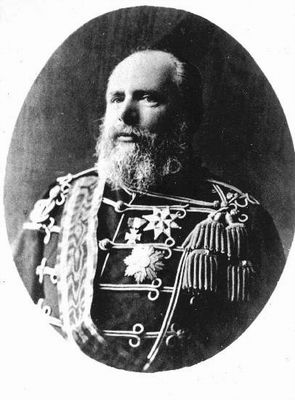
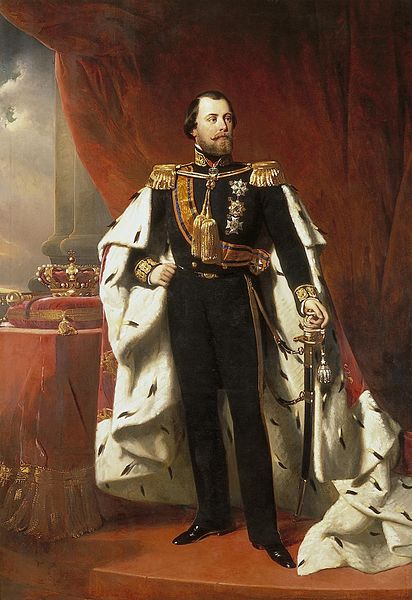
William III (Willem Alexander Paul Frederik Lodewijk, anglicized: William Alexander Paul Frederick Louis) (19 February 1817 – 23 November 1890) was from 1849 King of the Netherlands and Grand Duke of Luxembourg until his death and the Duke of Limburg until the abolition of the Duchy in 1866.
William was born in Brussels as son of William II of the Netherlands and Queen Anna Paulowna, daughter of Tsar Paul I of all the Russias and Empress Maria Fyodorovna (Sophie Dorothea of Württemberg). In his early years, he served in the military.
He married his first cousin, Sophie, daughter of King William I of Württemberg and Grand Duchess Catherine Pavlovna of Russia, in Stuttgart on 18 June 1839. This marriage was unhappy and was characterized by struggles about their children. Sophie was a liberal intellectual, hating everything leaning toward dictatorship, such as the army. William was simpler, more conservative, and loved the military. He prohibited intellectual exercise at home, for which action Queen Victoria of the United Kingdom, who corresponded with Sophie, called him an uneducated farmer. (His extramarital enthusiasms, however, led the New York Times to call him "the greatest debauchee of the age".) Another cause of marital tension (and later political tension) was his capriciousness; he could rage against someone one day, and be extremely polite the next.
William loathed the 1848 constitutional changes initiated by his father (William II) and Johan Rudolf Thorbecke. William II and Sophie saw them as key to the monarchy's survival in changing times. William himself saw them as useless limitations of royal power, and wished to govern like his grandfather, William I.
He tried to relinquish his right to the throne to his younger brother Henry. His mother convinced him to cancel this action. One year later (1849) William became King upon the death of his father.
King William III repeatedly contemplated abdicating as soon as his eldest son William, Prince of Orange, turned eighteen. This occurred in 1858, but as William was uncomfortable making a decision he remained King. His first act was the inauguration of the parliamentary cabinet of Thorbecke, the liberal designer of the 1848 constitution, whom William loathed.
When the Roman Catholic hierarchy of bishops was
restored in 1853 he found a reason to dismiss his rival. In the first
two decades of his reign, he dismissed several cabinets and disbanded
the States General several times, installing royal cabinets which ruled briefly as there was no support in elected parliament.
In 1856, William unilaterally instituted a new, reactionary constitution for Luxembourg in what has become known as the 'Coup of 1856'. He tried to sell the grand duchy in 1867, leading to the Luxembourg Crisis, which almost precipitated war between Prussia and France. However, the subsequent Second Treaty of London reestablished Luxembourg as a fully independent country.
During his reign, the King became more and more unpopular with his subjects – his whims provoking resistance and mockery.
He was the 963rd Knight of the Order of the Golden Fleece in Spain in 1842, the 777th Knight of the Order of the Garter in 1882 and the 72nd Grand Cross of the Order of the Tower and Sword.
In 1877, Queen Sophie died and years of war in the palace came to an end. In the same year, King William announced his intention to marry Eleonore d'Ambre, a French opera singer, whom he ennobled as countess d'Ambroise – without government consent. Under pressure from the government, he abandoned his marriage plans. In 1879, King William decided to marry Princess Emma of Waldeck and Pyrmont, a small German principality. Some politicians were quite angry, as she was 41 years the king's junior. Emma showed herself, however, as a cordial woman; and when William asked permission from parliament, this was easily granted and the couple were quickly married in Arolsen on 7 January 1879. She was not his first choice. He had previously been rejected by her sister, Princess Pauline of Waldeck and Pyrmont, as well as Princess Thyra of Denmark.
Emma
had a relieving influence on William's capricious personality and the
marriage was extremely happy. The last decade was without any doubt the
best of his reign. In 1880, Wilhelmina was
born. She became heiress presumptive in 1884 after the death of the
last remaining son from William's first marriage. Many potential heirs
had died between 1878 and 1884.
King William became seriously ill in 1887. However in 1888, he managed to personally hand over a gold medal of honor to naval hero Dorus Rijkers for saving the lives of 20 people.
He died in Het Loo in 1890. Because Wilhelmina had not yet reached adulthood, Emma became regent for
her daughter. She would remain regent until Wilhelmina's eighteenth
birthday in 1898. Because the Grand Duchy of Luxembourg could only be
inherited through the male line at the time, under Salic law, it went to Adolphe, the former Duke of Nassau.
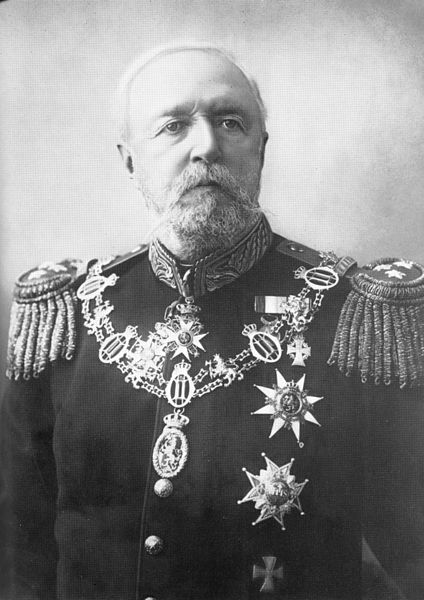
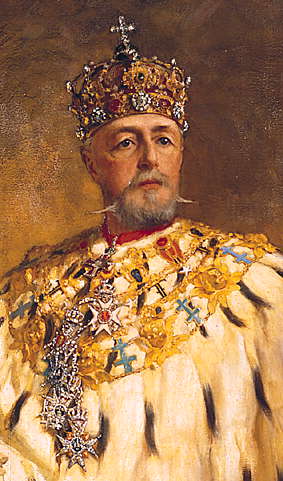
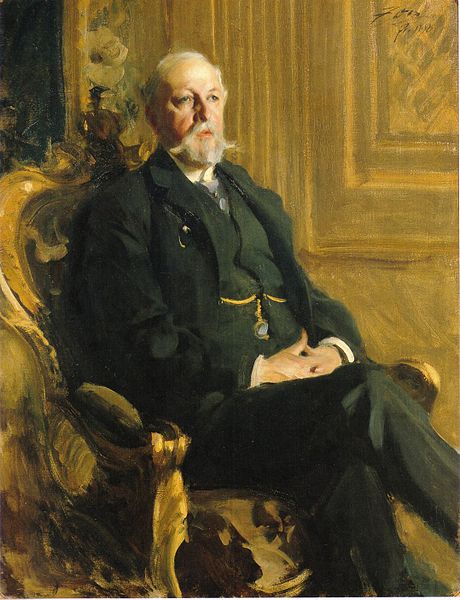
Oscar II (21 January 1829 – 8 December 1907), baptised Oscar Fredrik was King of Sweden from 1872 until his death and King of Norway from 1872 until 1905. The third son of King Oscar I of Sweden and Josephine of Leuchtenberg, he was a descendant of Gustav I of Sweden through his mother.
At his birth in Stockholm, Oscar Fredrik was created Duke of Östergötland. He entered the navy at the age of eleven, and was appointed junior lieutenant in July 1845. Later he studied at Uppsala University, where he distinguished himself in mathematics. On 13 December 1848, he was made an honorary member of the Royal Swedish Academy of Sciences.
On 6 June 1857 he married in Wiesbaden - Biebrich, Germany, Princess Sophia Wilhelmina, youngest daughter of Duke William of Nassau.
From 1859, when his father died, he was first in line to the Swedish throne after his oldest brother King Charles, who then had no male heirs (his son had died in infancy in 1854). His middle brother Gustaf had died in 1852.
He succeeded his brother Charles XV on 18 September 1872, and was crowned as king of Norway in the Nidaros Cathedral in Trondheim on 18 July 1873. At the accession he adopted as his motto Brödrafolkens väl /Broderfolkenes Vel ("The Welfare of the Brother Peoples"). While the King and the Royal Court resided mostly in Sweden, Oscar made the effort of learning to be fluent in Norwegian and
from the very beginning he realized the essential difficulties in the
maintenance of the union between the two countries. The political events
which led up to the peaceful dissolution of the union between Norway and Sweden in 1905 could hardly have been attained but for the tact and patience of the king himself. He was dethroned on 7 June 1905 by the Norwegian Parliament and renounced the Norwegian throne on
26 October. He declined, indeed, to permit any prince of his house to
become king of Norway, but better relations between the two countries
were restored before his death, which occurred in Stockholm on 8 December 1907.
His acute intelligence and his aloofness from the dynastic considerations affecting most European sovereigns gave the king considerable weight as an arbitrator in international questions. At the request of the United Kingdom, Germany and the United States in 1889 he appointed the chief justice of Samoa, and he was again called in to arbitrate in Samoan affairs in 1899. In 1897 he was empowered to appoint a fifth arbitrator if necessary in the Venezuelan dispute, and he was called in to act as umpire in the Anglo - American arbitration treaty that was quashed by the United States Senate. He won many friends in the United Kingdom by his outspoken and generous support of Britain at the time of the Second Boer War (1899 – 1902), expressed in a declaration printed in The Times of the 2 May 1900, when continental opinion was almost universally hostile.
He was the 1,027th Knight of the Order of the Golden Fleece in Spain and the 774th Knight of the Order of the Garter in 1881.
Himself a distinguished writer and musical amateur, King Oscar proved a generous friend of learning, and did much to encourage the development of education throughout his dominions. In 1858 a collection of his lyrical and narrative poems, Memorials of the Swedish Fleet, published anonymously, obtained the second prize of the Swedish Academy. His "Contributions to the Military History of Sweden in the Years 1711, 1712, 1713," originally appeared in the Annals of the Academy, and were printed separately in 1865. His works, which included his speeches, translations of Herder's Cid and Goethe's Torquato Tasso, and a play, Castle Cronberg, were collected in two volumes in 1875 – 76, and a larger edition, in three volumes, appeared in 1885 – 88. His Easter hymn and some other of his poems are familiar throughout the Scandinavian countries. His Memoirs of Charles XII of Sweden were translated into English in 1879. In 1881 he founded the World's first open - air museum at his summer residence near Christiania, now Oslo. In 1885 he published his Address to the Academy of Music, and a translation of one of his essays on music appeared in Literature in May 1900. He had a valuable collection of printed and manuscript music, which was readily accessible to the historical student of music.
Being a theater lover, he commissioned a new opera house to be built by Axel Anderberg for the Royal Swedish Opera which was inaugurated on September 19, 1898. It is until today the current home of that institution. Oscar II told Henrik Ibsen that his Ghosts was "not a good play". As he was dying, he requested that the theaters not be closed on account of his death. His wishes were respected.
King Oscar II was an enthusiast of Arctic exploration. Along with Swedish millionaire Oscar Dickson and Russian magnate Aleksandr Mikhaylovich Sibiryakov, he was the patron of a number of pioneering Arctic expeditions in the 1800s. Among the ventures the king sponsored, the most important are Adolf Erik Nordenskiöld's explorations to the Russian Arctic and Greenland, as well as Fridtjof Nansen's Polar journey on the Fram.
The name and portrait of Oscar II has been used as a trademark for the King Oscar sardines as well as for gingerbread cookies (pepparkakor) and other bakery products made by Göteborgs Kex AB.
King Oscar II was married to Sophia of Nassau.
Oscar II (unlike his father) never officially recognized any illegitimate children of his. He is also alleged to have had two sons with the actress Marie Friberg, Nils and August Ekstam (the latter born 1878).
His eldest son, Oscar Gustaf Adolf, duke of Värmland, succeeded him as King Gustaf V of Sweden. His second son, Oscar, resigned his royal rights on his marriage in 1888 with a lady - in - waiting, Miss Ebba Munck, when he assumed the title of Prince Bernadotte and from 1892 he was known as Count Wisborg. The king's other sons were Charles, duke of Västergötland, who married Princess Ingeborg of Denmark; and Eugén, duke of Närke, well known as an artist.
As King of Norway, he was, after the events of 1905, succeeded by his grandnephew Prince Carl of Denmark, grandson of his late elder brother King Charles, who ascended the Norwegian throne in 1905 with reign name Haakon VII.
Harald V of Norway, the great - grandson of Oscar II (grandson of his third son duke of Västergötland), succeeded in 1991 to the throne of Norway once held by his great - grandfather, Oscar II.